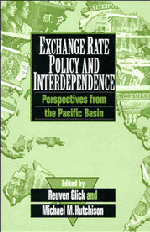Book contents
- Frontmatter
- Contents
- List of contributors
- Preface
- Exchange rate policy and interdependence
- 1 Overview
- I International financial market integration
- II Choice of exchange rate regimes
- 5 Exchange rate management: a partial review
- 6 Exchange rate policy and insulation from external shocks: the cases of Korea and Taiwan, 1970–1990
- 7 Trade price shocks and insulation: Australia's experience with floating rates
- 8 The role of the exchange rate in New Zealand monetary policy
- 9 Officially floating, implicitly targeted exchange rates: examples from the Pacific Basin
- III Intervention and sterilization policies
- IV Prospects for a yen bloc
- Index
5 - Exchange rate management: a partial review
Published online by Cambridge University Press: 04 May 2010
- Frontmatter
- Contents
- List of contributors
- Preface
- Exchange rate policy and interdependence
- 1 Overview
- I International financial market integration
- II Choice of exchange rate regimes
- 5 Exchange rate management: a partial review
- 6 Exchange rate policy and insulation from external shocks: the cases of Korea and Taiwan, 1970–1990
- 7 Trade price shocks and insulation: Australia's experience with floating rates
- 8 The role of the exchange rate in New Zealand monetary policy
- 9 Officially floating, implicitly targeted exchange rates: examples from the Pacific Basin
- III Intervention and sterilization policies
- IV Prospects for a yen bloc
- Index
Summary
Introduction
All countries, either explicitly or implicitly, have some form of exchange rate policy. This may involve doing nothing and letting the exchange rate fluctuate freely in response to market forces – a purely flexible exchange rate – or it may involve some kind of active intervention directed toward the attainment of certain specified objectives. Historically, a wide range of exchange rate policies have been adopted by individual nations in the world economy. In the recent past, the most dramatic change was the collapse of the Bretton Woods system in 1973, when the world moved generally from more fixed to more flexible exchange rate arrangements, although the regimes that individual economies chose to adopt were quite diverse.
This diversity of approaches to exchange rate policy is also characteristic of the Pacific Rim economies, which, while generally following the move toward more flexibility, have done so in a variety of ways and to various degrees. Thus, as Glick and Hutchison argue in Chapter 1 of this volume, the Pacific Rim region offers an excellent laboratory in which to compare various exchange rate arrangements and their consequences for monetary policy. Several of the developments are well documented by the relevant chapters in this volume. As discussed by Moreno in Chapter 6, during the 1970s both Taiwan and Korea maintained adjustable pegs to the U.S. dollar, and both economies adopted more flexible policies by the end of the decade.
- Type
- Chapter
- Information
- Exchange Rate Policy and InterdependencePerspectives from the Pacific Basin, pp. 99 - 137Publisher: Cambridge University PressPrint publication year: 1994
- 1
- Cited by



